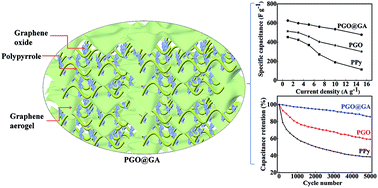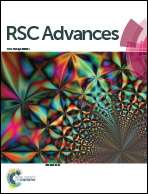Pulse electrochemical synthesis of polypyrrole/graphene oxide@graphene aerogel for high-performance supercapacitor†
Abstract
A novel electroactive polypyrrole/graphene oxide@graphene aerogel (PGO@GA) was synthesized for the first time by pulse electropolymerization. The off-time in this technique allows polypyrrole (PPy) to go through a more stable structural arrangement, meanwhile its electronic transmission performance is enhanced by immobilizing graphene oxide between PPy chains. Moreover, graphene aerogel provides a three-dimensional structure with high conductivity to protect PPy from swelling and shrinking during the capacitive testing. Under these synergistic effects, PGO@GA presents exceptional capacitive performances including high specific capacitance (625 F g−1 at 1 A g−1), excellent rate capability (keeping 478 F g−1 at 15 A g−1 with retention rate of 76.5%), and excellent cycling life (retaining 85.7% of its initial value when cycling 5000 times at 10 A g−1). Therefore, the strategy adopted by this research provides a good reference for preparing other PPy-based electrode materials applied in the fields of catalysis, sensing, adsorption and energy storage.



 Please wait while we load your content...
Please wait while we load your content...